» posted on Thursday, April 4th, 2013 by Linda Lou Burton
It’s All In Stock
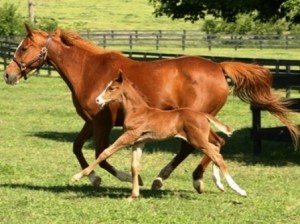 Linda Burton posting from Frankfort, Kentucky – “It’s all in stock.” That’s what my grandma used to say when viewing a newborn. If the baby was especially fine-looking, she’d add “Good stock,” and ooo and coo and ask to hold the little one. A really ugly baby had no such luck with Grandma, she’d simply hand a baby gift to the new mama with best wishes. In the car later, she’d express her concern for the baby’s future. “Poor thing, hasn’t got a chance,” she’d fret. “But it can’t help it, it doesn’t come from good stock.” Believing everyone deserves a chance, I’d chastise Grandma, but I never changed her mind. Grandma’s been dead for 30 years, but I swear, she was tapping my shoulder today, saying “I told you so.” I was standing in a horse barn, and Oscar
Linda Burton posting from Frankfort, Kentucky – “It’s all in stock.” That’s what my grandma used to say when viewing a newborn. If the baby was especially fine-looking, she’d add “Good stock,” and ooo and coo and ask to hold the little one. A really ugly baby had no such luck with Grandma, she’d simply hand a baby gift to the new mama with best wishes. In the car later, she’d express her concern for the baby’s future. “Poor thing, hasn’t got a chance,” she’d fret. “But it can’t help it, it doesn’t come from good stock.” Believing everyone deserves a chance, I’d chastise Grandma, but I never changed her mind. Grandma’s been dead for 30 years, but I swear, she was tapping my shoulder today, saying “I told you so.” I was standing in a horse barn, and Oscar 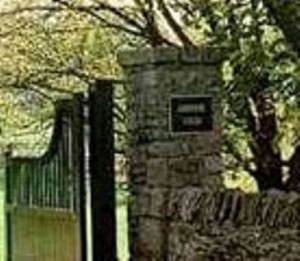 was explaining to the five of us the specific details of horse breeding. What is the definition of a thoroughbred horse? I’d never thought to ask before, but here I am, on my 74th birthday, touring a Kentucky horse farm, and that’s just the first new thing I learned today. A thoroughbred horse comes to life, ah, shall we say, naturally; no artifical processes involved. The tourbus had brought us to Airdrie Stud, 2,500 acres of gently rolling, limestone-rich bluegrass land on Old Frankfort Pike, owned by former Kentucky governor Brereton Jones since 1972; where more than 140
was explaining to the five of us the specific details of horse breeding. What is the definition of a thoroughbred horse? I’d never thought to ask before, but here I am, on my 74th birthday, touring a Kentucky horse farm, and that’s just the first new thing I learned today. A thoroughbred horse comes to life, ah, shall we say, naturally; no artifical processes involved. The tourbus had brought us to Airdrie Stud, 2,500 acres of gently rolling, limestone-rich bluegrass land on Old Frankfort Pike, owned by former Kentucky governor Brereton Jones since 1972; where more than 140  stakes winners and earners of over $80,000,000 have been bred. It’s really cold for April; the grass hasn’t greened up yet; a chilling breeze swept through the barn, but the horses were steaming from their morning bath. These horses are hot all right; Oscar pointed to the chart on the wall; it’s the “appointment schedule” for the day. Three studs had an 8 AM mating; next call is 2 PM. Oscar explained how it’s done.
stakes winners and earners of over $80,000,000 have been bred. It’s really cold for April; the grass hasn’t greened up yet; a chilling breeze swept through the barn, but the horses were steaming from their morning bath. These horses are hot all right; Oscar pointed to the chart on the wall; it’s the “appointment schedule” for the day. Three studs had an 8 AM mating; next call is 2 PM. Oscar explained how it’s done.
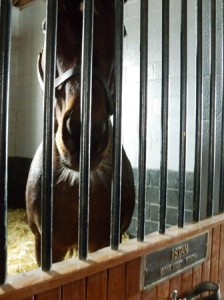 No wine and roses for this dating scene; it’s all business; carefully planned and choreographed. The boys are here – Istan, Majesticperfection, Proud Citizen, Stevie Wonderboy, Brother Derek – eleven studs in all; the girls are brought from their home farm for the event. I need to change my lingo now; it’s stallions and mares; parents are referred to as sires and dams. The vet determines the optimum moment for the mares success at a pregnancy; a call is made; the appointment confirmed. The mare must have papers certifying she is free from disease (and will not infect a million-dollar stud); a culture is taken just before she arrives. First into the teaser stall; a closed window separates that room from the one beside. A male “teaser” is brought into the adjoining room; he’s wearing a vest, so no chance of an accidental impregnation; the window is opened and the female’s reaction to a male is observed. If it’s favorable, the teaser is taken away and she is thoroughly washed and cleaned (to protect the stud); then led into the large breeding room.
No wine and roses for this dating scene; it’s all business; carefully planned and choreographed. The boys are here – Istan, Majesticperfection, Proud Citizen, Stevie Wonderboy, Brother Derek – eleven studs in all; the girls are brought from their home farm for the event. I need to change my lingo now; it’s stallions and mares; parents are referred to as sires and dams. The vet determines the optimum moment for the mares success at a pregnancy; a call is made; the appointment confirmed. The mare must have papers certifying she is free from disease (and will not infect a million-dollar stud); a culture is taken just before she arrives. First into the teaser stall; a closed window separates that room from the one beside. A male “teaser” is brought into the adjoining room; he’s wearing a vest, so no chance of an accidental impregnation; the window is opened and the female’s reaction to a male is observed. If it’s favorable, the teaser is taken away and she is thoroughly washed and cleaned (to protect the stud); then led into the large breeding room. 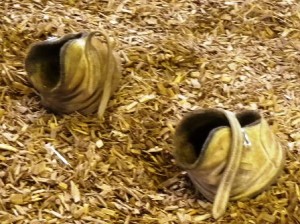 Five people have assigned jobs to do; boots are placed on her back legs (to protect the stud from getting kicked); two people stand at her head, and two behind; then the stud is brought from his stall. Three minutes later, the stud is returned to his stall and the mare is taken home to resume her day. A sonogram in two weeks determines if there was success; she can be brought back if nothing “took;” even so, no stud fee is due until a baby (excuse me, foal) is born, and nursing.
Five people have assigned jobs to do; boots are placed on her back legs (to protect the stud from getting kicked); two people stand at her head, and two behind; then the stud is brought from his stall. Three minutes later, the stud is returned to his stall and the mare is taken home to resume her day. A sonogram in two weeks determines if there was success; she can be brought back if nothing “took;” even so, no stud fee is due until a baby (excuse me, foal) is born, and nursing.
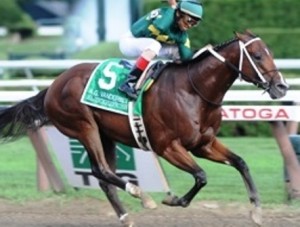 Bloodline is everything (as Grandma used to say). The thoroughbred line is a pure breed of horse descended from English mares and Arabian stallions, most often used for racing (“purity” is why the in-person, carefully observed, videotaped breeding is so important). Winning races brings fortune and fame to owners; but even the non-informed among us get caught up every first Saturday in May when it’s Derby Day at Churchill Downs. Outrageous hats and heart-touching stories get us in the mood for three minutes of hot-footed racing; the jockeys in their colorful silks atop gorgeous powerfully muscled animals; the winner’s circle; and then we wait for the next race – the Preakness, will there be a Triple Crown? I imagined the thrill the owners must feel;
Bloodline is everything (as Grandma used to say). The thoroughbred line is a pure breed of horse descended from English mares and Arabian stallions, most often used for racing (“purity” is why the in-person, carefully observed, videotaped breeding is so important). Winning races brings fortune and fame to owners; but even the non-informed among us get caught up every first Saturday in May when it’s Derby Day at Churchill Downs. Outrageous hats and heart-touching stories get us in the mood for three minutes of hot-footed racing; the jockeys in their colorful silks atop gorgeous powerfully muscled animals; the winner’s circle; and then we wait for the next race – the Preakness, will there be a Triple Crown? I imagined the thrill the owners must feel;  like Sheik Mohammed, a man of royalty; ruler of Dubai and vice-president of the United Arab Emirates. He owns one of the premier thoroughbred racing and breeding operations in the world; his horses race under royal blue silks. The Sheik has not yet succeeded in capturing the elusive Kentucky Derby; his Bernardini won the Preakness in 2006 and his horses have won some of the most prestigious races in Australia, France, Ireland, Japan, the United Kingdom, and Dubai. He continues to try, however; and he’s in Lexington every year for the sales, continuing to look for just the right horse.
like Sheik Mohammed, a man of royalty; ruler of Dubai and vice-president of the United Arab Emirates. He owns one of the premier thoroughbred racing and breeding operations in the world; his horses race under royal blue silks. The Sheik has not yet succeeded in capturing the elusive Kentucky Derby; his Bernardini won the Preakness in 2006 and his horses have won some of the most prestigious races in Australia, France, Ireland, Japan, the United Kingdom, and Dubai. He continues to try, however; and he’s in Lexington every year for the sales, continuing to look for just the right horse.
 Beyond the fame and glory, as the proverbial line goes, “winning isn’t everything” – the real money in owning a fabulous horse comes from those stud fees after the wins. And every win of your babies raises your value, and hence your stud fee. Take Majesticperfection, a beautiful stallion I chatted with for a moment today (we were forbidden to pet them); he is billed as “America’s most profitable first-crop sire.” His 16 weanlings averaged $55,000 a sale, with a high of $145,000. His trainer Steve Asmussen called him “the fastest horse I’ve ever seen,” so who wouldn’t want to buy his babies? Proud Citizen, in the next stall, was sire of 11 North American stakes winners in 2012, leading all US sires. Oscar led us past each stall; we stopped at
Beyond the fame and glory, as the proverbial line goes, “winning isn’t everything” – the real money in owning a fabulous horse comes from those stud fees after the wins. And every win of your babies raises your value, and hence your stud fee. Take Majesticperfection, a beautiful stallion I chatted with for a moment today (we were forbidden to pet them); he is billed as “America’s most profitable first-crop sire.” His 16 weanlings averaged $55,000 a sale, with a high of $145,000. His trainer Steve Asmussen called him “the fastest horse I’ve ever seen,” so who wouldn’t want to buy his babies? Proud Citizen, in the next stall, was sire of 11 North American stakes winners in 2012, leading all US sires. Oscar led us past each stall; we stopped at  Istan’s door; he was waiting for his peppermint. “He loves his sweets,” Oscar laughed as Istan gobbled up his treat. We went into the feed room to see what horses eat, oats and a formulated dry food, with lots of protein. Outside, they graze on the famous “bluegrass” – rich in minerals from the limestone just beneath the surface of the ground. “We lost a horse yesterday,” Oscar told us, leading us to the freshly covered grave. “It was Slew City Slew, son of Seattle Slew, he was 29 years old and died of the same problem his father had.”
Istan’s door; he was waiting for his peppermint. “He loves his sweets,” Oscar laughed as Istan gobbled up his treat. We went into the feed room to see what horses eat, oats and a formulated dry food, with lots of protein. Outside, they graze on the famous “bluegrass” – rich in minerals from the limestone just beneath the surface of the ground. “We lost a horse yesterday,” Oscar told us, leading us to the freshly covered grave. “It was Slew City Slew, son of Seattle Slew, he was 29 years old and died of the same problem his father had.”
We wound up the farm portion of our tour at Hill N Dale Farms for a brief stop at the grave of Seattle Slew (1974-2002), the only undefeated Triple Crown winner. Seattle Slew, owned by the Taylors of White Swan, Washington, made his racing debut on September 20, 1976. He won all three races in his two-year-old campaign; his accomplishments earned him the Eclipse Award for being the best two-year-old in North America. In 1977, Slew won six more consecutive races including the Triple Crown. He won Eclipse Awards as the top three-year-old colt in North America and the Horse of the Year. In 1978 he fought off a life-threatening collapsed left jugular vein;  Slew also overcame a suspensory ligament injury, a filled ankle, and several other hurdles, but he emerged and produced some of the greatest performances of all-time. After leaving the track with a career racing record of 14 firsts and 2 seconds in 17 races and earnings of $1,208,726, Seattle Slew sired over 100 Stakes-winners; he earned the title of “most complete thoroughbred the industry has ever seen.” 25 years to the day after he won the Kentucky Derby, Seattle Slew died in his sleep at age 28.
Slew also overcame a suspensory ligament injury, a filled ankle, and several other hurdles, but he emerged and produced some of the greatest performances of all-time. After leaving the track with a career racing record of 14 firsts and 2 seconds in 17 races and earnings of $1,208,726, Seattle Slew sired over 100 Stakes-winners; he earned the title of “most complete thoroughbred the industry has ever seen.” 25 years to the day after he won the Kentucky Derby, Seattle Slew died in his sleep at age 28.
Okay Grandma, I’ll concede, some things may be connected to “good stock.”
Progeny Reports for Airdrie Stud http://www.stallionupdates.com/clients/airdrie/airdrie.php?goto=istan-ISTAN&repyear=&rnumber=3
About the Stallions at Airdrie Stud http://airdriestud.com/list_all.asp?header=stallions
About Seattle Slew http://www.seattleslew.com/
Note: Tomorrow’s post will cover the last half of my Horses, Hooch & History Bluegrass Tour about the other thing Kentucky is famous for: bourbon distilleries.
About Bluegrass Tours http://www.bluegrasstours.com/
